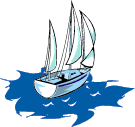SHIP MAKING AND SHIP REGATTA

SHORT TERM GOALS:
- To allow the students to become familiar with the advancement
of sailing crafts and ship designs from ancient worlds to modern
sailing designs.
- To give the students the opportunity to incorporate prior
knowledge in building a ship of their own.
- To provide students with an opportunity to use various sources
(books, magazines, etc.) to learn more about ships, shipbuilding,
and important factors to take into consideration when building a
ship.
TIME ALLOTMENT: 2 3/4 hours
CONTENT AREAS ADDRESSED:
(1) Science
(2) Math
(3) Language Arts
(4) Art
CONCEPTS ADDRESSED:
(1) Critical Thinking
(2) Comparing
(3) Testing
(4) Communicating
(5) Cooperating
Materials:
(1) Resource books
(2) Styrofoam
(3) Empty 2ml bottles
(4) Toothpicks
(5) Straws
(6) Cloth
(7) Construction Paper
(8) Butcher Trays
(9) Popsicle Sticks
(10) Rain Gutters
(11) Clay
(12) Glue
(13) Wood Blocks
(14) Ship Terminology handout
PROCEDURE:
- Throughout the study on ships and sailing, the students have
begun to understand the concept of buoyancy, as well as the
factors involved in buoyancy such as density, weight, and surface
area. To see how well the students have understood these concepts,
allow them to design their own ships.
- Have several informational books available for the students to
look through for design ideas and clues on how to make sails. A
few examples are listed in the Resources at the end of this
lesson.
- Provide a number of materials for the students to use to build
their ship, so they can use their own creativity to decide which
material would work best for the parts of the ship. (Example: The
students could use a butcher tray for the bottom of the boat,
toothpicks to build the masts, and construction paper to build the
sails.)
- Allow the students to work in groups of two because the
students will need the extra hand in developing the sails and
holding the parts of the ship together. They will also be able to
make the ship more complex if two are working instead of just one.
- While the students are working, the teacher can walk around
the room offering helpful suggestions whenever there is evidence
of confusion or difficulty.
- As the students are finishing up on their ship/boat, allow
them to discuss with each other why they put their boat together
the way they did. They could possibly make a list of the materials
they used and why for later discussion.
SHIP REGATTA:
- Because the students put so much time and effort into their
ships, they should be given an opportunity to test their ships in
water. While the students are building their ships, they can be
given opportunities to test the materials to make sure the
concepts of buoyancy are being used properly. But as a final
activity, possibly allow the students to set up a bracket for a
ship regatta for double elimination, single elimination, or a
round robin.
- Give the students a little time for trial runs in some rain
gutters which are plugged at the ends. The students will have to
decide among themselves who will be the one to compete, but the
other students can cheer. The students will then begin the
competition by setting the two rain gutters next to each other,
starting the ships at one end, and using their own "hot air"
(breath) to blow the ships to the opposite end of the rain
gutters. The first ship to reach the end will be the winner of
that round.
- After the final races have been completed, awards can be given
out to the participants and the winner.
- Allow the students to discuss with each other why some of the
boats floated or sailed better than others. Ask them to make
comparisons between the ships, so the students can see how their
ship could be improved.
ASSESSMENT:
- Observation Checklist
- Group Participation Rubric
- The ship regatta will tell how well the students put their
ships together in relation to the concept of buoyancey because
they will either float or not float. This will help determine how
well the students understood the concepts involved in building a
ship.
EXTENSIONS:
- Take the students to a shipyard so they can see first hand how
ships are built. There should also be someone there who is capable
of explaining the process and detail of such a project.
- Develop a more complex classroom ship, which will incorporate
more woodworking, cooperation, and planning.
RESOURCES:
Everett-Fisher, L. (1971). The shipbuilders. New York:
Franklin Watts, Inc. [ISBN: 531-01043-0]
Goldsmith-Carter, G. (1970). Sailing ships and sailing
craft. New York: Grossett and Dunlap, Inc. [ISBN: Unavailable]
Martin, J.H. (1985). Pictorial history of ships. Norwalk:
Longmeadow Press. [ISBN: 0-9042-30-22-8]
Go to;
Buoyancy "What Makes it Float?" lesson
Adopt-a-Sea Monster lesson
Table of Contents
St. Norbert College Ocean
Voyager's Program

